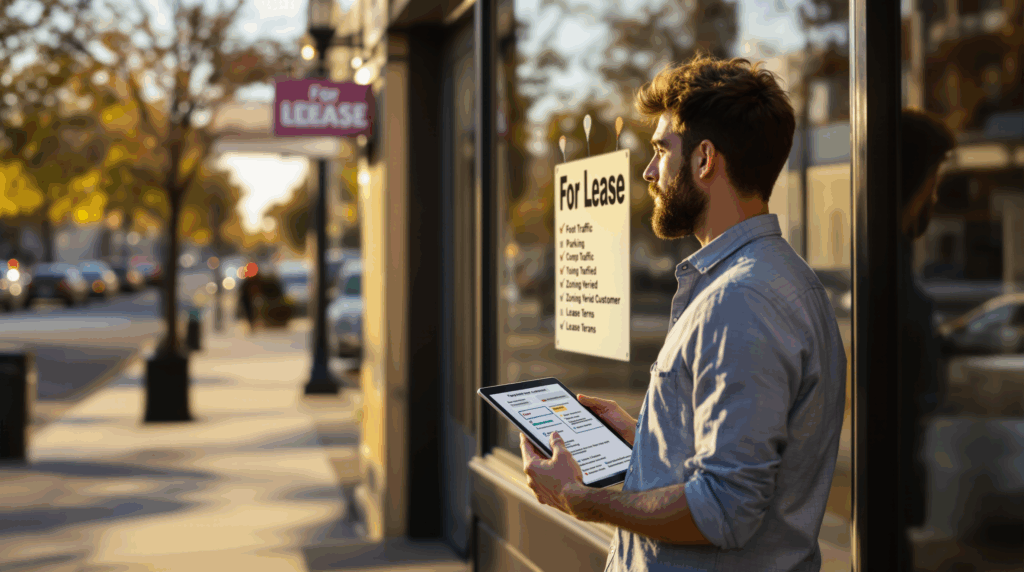You’ve laid the groundwork with planning, funding, legal checks, and pricing strategies. Now comes one of the most tangible and impactful decisions you’ll make: choosing the physical location for your bakery. The old real estate adage “location, location, location” holds immense weight for retail businesses, especially bakeries that often rely on foot traffic, visibility, and community connection. The right spot can significantly boost your chances of success, while the wrong one can be an anchor dragging you down, regardless of how delicious your pastries are. This decision requires careful research, analysis, and foresight – it’s far more than just finding an empty storefront.
The Most Important Real Estate Decision You’ll Make
Unlike tweaking a recipe or adjusting a marketing campaign, your physical location is a long-term commitment, usually locked in by a multi-year lease. It dictates:
- Visibility and Customer Access: How easily can potential customers find you and get to you?
- Foot Traffic Potential: Will enough people naturally pass by your shop?
- Brand Image: Does the location align with the quality and style of your bakery?
- Operational Efficiency: Does the space support your kitchen workflow and storage needs?
- Operating Costs: Rent, utilities, and other location-based expenses significantly impact your bottom line.
Choosing wisely requires a methodical approach, aligning potential sites with your specific business needs and goals outlined in your business plan.
Step 1: Defining Your Ideal Location Profile – Know What You Need
Before you even start Browse listings, define what your ideal location looks like based on your unique bakery concept.
- Target Audience Alignment: Where do your ideal customers (identified in your market analysis) live, work, commute, or spend their leisure time? Your location must be convenient and appealing to them. A bakery targeting busy office workers needs a different location than one aimed at families in a residential neighborhood or tourists in a downtown area.
- Bakery Concept Fit: What’s the vibe of your bakery?
- High-End Patisserie: Might thrive in an upscale shopping district, a charming historic downtown, or near luxury boutiques.
- Cozy Neighborhood Bakery: Needs to be easily accessible to local residents, perhaps on a main street within a neighborhood or a small local retail strip.
- Quick Grab-and-Go Focus: Requires high foot traffic, visibility, and easy in-and-out access, possibly near transit hubs or office complexes.
- Destination Bakery (Unique Niche): If your product is truly unique and sought-after, you might have slightly more flexibility, but accessibility remains important.
- Space Needs: How much square footage do you realistically need? Consider kitchen size (often 50-60% or more of the space), dry/cold storage, prep areas, dishwashing station, office space (even small), restrooms, and the customer area (seating vs. primarily takeout).
- Operational Requirements:
- Can the space accommodate your planned kitchen layout efficiently?
- Are there suitable areas for receiving deliveries without disrupting customers?
- Crucially, does the site have adequate utilities – sufficient electrical capacity for commercial ovens and mixers (check amperage!), potentially natural gas hookups, adequate water supply and drainage? Upgrading utilities can be extremely expensive.
- Budget Constraints: What is the maximum monthly rent (including additional costs like CAM charges – see lease section below) that your financial projections can support? Be realistic. Rent is often one of the largest fixed expenses. Don’t stretch your budget too thin, especially in the beginning.
Step 2: Scouting Potential Areas and Sites – Where to Look
With your ideal profile in mind, start exploring potential neighborhoods and specific sites.
- Identify Promising Areas: Based on your target audience and concept, which neighborhoods, districts, or types of shopping centers (strip malls, lifestyle centers, downtown blocks) seem like a good fit?
- Assess Visibility and Accessibility:
- Foot Traffic: Visit potential areas at different times of day and days of the week. Observe who is walking by. Are they your target customers? Is the volume sufficient? High foot traffic is often desirable but doesn’t guarantee success if it’s the wrong demographic or people are rushing past.
- Vehicle Traffic & Parking: How easy is it for customers to reach you by car? Is visible, convenient, and affordable parking readily available? Consider street parking rules (meters, time limits), nearby parking lots or garages, and ease of access. Think about delivery driver access as well.
- Signage Opportunities: Can you install clear, attractive signage that’s easily visible from the street? Check local city/county ordinances regarding sign size, type, and placement. Good signage is crucial advertising.
- Accessibility: Is the entrance easily accessible for everyone, including people with disabilities (meeting Americans with Disabilities Act – ADA requirements)? Consider ramps, door width, etc.
- Analyze the Competition (Location Context):
- Map out nearby direct competitors (other bakeries) and significant indirect ones (grocery stores, cafes selling pastries).
- Is the area already saturated, or is there room for your specific niche?
- Sometimes being near complementary businesses (coffee shops without strong pastry programs, gift shops, bookstores, offices) can be beneficial, creating cross-traffic. Avoid being right next door to a very similar, established bakery unless you have a powerful differentiating factor.
- Evaluate Safety and Ambiance: Does the block and surrounding area feel safe and welcoming for both customers and your employees, especially if you have early morning or later evening hours? Is the area well-maintained? What is the overall character – vibrant, quiet, professional, family-oriented? Ensure it aligns with your brand.
Step 3: Evaluating Specific Properties – Digging Deeper
Once you’ve identified promising available spaces, investigate them thoroughly.
- Site History: Find out about previous tenants. Why did they leave? A history of frequent turnover, especially among food businesses, could indicate underlying problems with the location or the landlord. If the previous tenant was also a food business, some necessary infrastructure (like plumbing for sinks, ventilation rough-ins) might already be in place, potentially saving costs.
- Size, Layout, and Flow: Walk through the space carefully. Visualize your kitchen layout, storage areas, and customer flow. Are there awkward structural elements (columns, odd angles) that hinder efficiency? Is the ceiling height adequate for ventilation hoods? Does the proportion of kitchen space to customer space work for your model?
- Condition and Infrastructure: This requires careful inspection, potentially with professional help (contractor, electrician, plumber) before signing a lease.
- HVAC (Heating, Ventilation, Air Conditioning): Is the system adequate for a commercial kitchen’s heat load and in good working order?
- Electrical: Can the existing electrical panel and wiring handle the heavy load of commercial ovens, mixers, refrigerators? Upgrades can be very expensive.
- Plumbing: Check for leaks, adequate water pressure, condition of pipes, and existing connections for sinks and dishwashers. Is there a grease trap, and is it compliant with local codes?
- Restrooms: Are they compliant with ADA requirements and local health codes?
- Overall Condition: Look at floors, walls, ceilings, windows, doors. Are significant repairs or renovations needed? Factor these costs into your budget.
- Zoning Verification: DO NOT SKIP THIS STEP. Independently verify with the local city or county Planning and Zoning Department that a “bakery” or “food service establishment” is a permitted use for that specific property address. Do not rely solely on the landlord or real estate agent’s word. Zoning issues can halt your project entirely.
- Utilities Check: Confirm the availability and capacity of essential utilities (gas, electric, water, sewer) directly with the utility providers if possible.
Step 4: Understanding the Lease – Don’t Sign Blindly
A commercial lease is a complex, legally binding document. Understanding its terms is crucial, and professional legal review is essential.
- Key Lease Terms to Scrutinize:
- Rent: Understand the base rent amount. Are there annual increases (escalation clause)? How are they calculated (fixed amount, percentage, tied to an index)? Is there percentage rent (common in malls, where you pay a percentage of sales above a certain threshold)?
- Lease Term: How many years is the lease? (3-10 years is common). Are there options to renew? Under what terms? A shorter term offers flexibility but less security; a longer term provides stability but less flexibility.
- Security Deposit: How much is required? Under what conditions is it returned?
- Use Clause: This defines specifically what business activities are permitted in the space. Ensure it’s broad enough to cover your current and potential future offerings (e.g., adding coffee, light lunch items, classes). Try to negotiate an “exclusivity clause” if possible, preventing the landlord from leasing another space in the same property to a direct competitor.
- Operating Expenses (NNN, Gross, Modified Gross): This is critical. Who pays for property taxes, property insurance, and common area maintenance (CAM – costs for parking lots, landscaping, hallways, etc.)?
- Triple Net (NNN) Lease: Tenant pays base rent PLUS taxes, insurance, and CAM. Common for standalone buildings or small centers. Requires careful budgeting for potentially variable costs.
- Gross Lease: Tenant pays a flat rent; landlord covers operating expenses. Simpler budgeting for tenant, but rent is usually higher.
- Modified Gross: A hybrid where tenant and landlord share responsibility for operating expenses. Understand exactly what structure is used and estimate these additional costs!
- Tenant Improvements (TI) / Build-Out: Does the landlord offer a TI allowance (a certain amount of money per square foot) or agree to perform specific work (“vanilla box” finish) to help you prepare the space? This is often negotiable.
- Maintenance and Repairs: Clearly outlines who is responsible for repairing different parts of the property (roof, HVAC, plumbing, electrical, structure vs. interior non-structural elements).
- Assignment and Subletting: Can you transfer the lease to someone else if you sell your business or need to move? Landlord approval is usually required, but the conditions matter.
- Default and Remedies: What happens if you fail to pay rent or violate other lease terms? Understand the cure periods and landlord’s rights.
- Negotiate Key Terms: Don’t assume the first draft of the lease is final. Many points are negotiable, especially in a tenant’s market. Ask for what you need (e.g., a rent abatement period during your build-out, specific repairs, options to renew, caps on CAM increases).
- Get Professional Legal Review: Before signing anything, have an attorney experienced in commercial real estate leases in your specific state review the entire document. They can identify red flags, explain complex clauses, and help you negotiate favorable terms. This fee is an essential investment.
Location Beyond the Walls: Community and Future Growth
- Community Fit: Does the neighborhood’s character resonate with your brand? Are there opportunities to engage with the local community (events, schools, farmers’ markets)? Positive community relations can be great for business.
- Future Development: Research any planned construction, road changes, or major developments nearby (check city planning department). Will these bring more potential customers, or create disruptive construction or new competition?
- Scalability: While focusing on startup needs, consider if the location offers any long-term potential for growth, either within the space or nearby, should your bakery become highly successful.
Trust Your Gut, But Verify Everything
Choosing a location blends objective analysis with a degree of intuition. Does the space feel right? Can you envision your successful bakery operating there? However, never let enthusiasm overshadow due diligence. Visit potential sites multiple times. Talk to neighboring business owners about their experiences with the area and the landlord. Research traffic patterns. Scrutinize the lease. Verify zoning independently. Taking the time to choose the right location is laying a strong foundation for your bakery’s future success.







